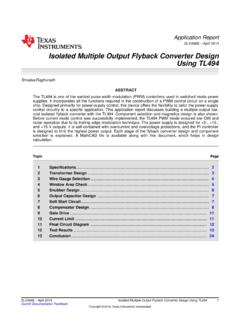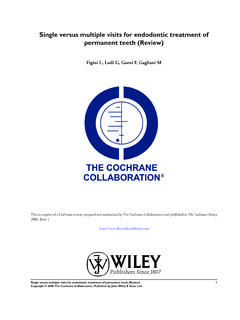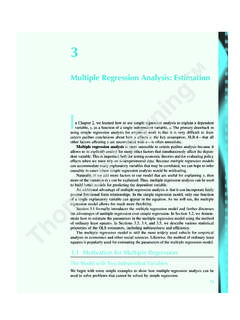Transcription of Monochorionic Multiple Pregnancy and Twin to …
1 Monochorionic Multiple Pregnancy and twin to twin Transfusion Syndrome Introduction If you are pregnant with more than one baby (twins, triplets or more), the sonographer or physician will look very carefully when you are scanned to see whether each baby has its own FACT SHEET. placenta (dichorionic) or if they both share one placenta ( Monochorionic ). If there is only one placenta these babies will be monozygotic multiples (MZ, identical). These pregnancies are referred to as Monochorionic (MC) because of the shared placenta and one chorionic membrane surrounding the unborn babies.
2 As you will see from the diagram, both babies are surrounded by one chorionic membrane, and each of the babies may be surrounded by their own amniotic membrane, the inner membrane, or they may share one amniotic membrane. Diagram 1 Single Placenta Diagram 2 Single Placenta with 1 chorion and 2 amnions with 1 chorion and 1 amnion Please refer to the Biology of Multiples Fact Sheet for more details on monozygotic (MZ). Multiple pregnancies. Monochorionic pregnancies are monitored by more frequent scans as there is a chance of developing a condition known as twin to twin Transfusion Syndrome which can be serious.
3 This document will provide you with information about TTTS, one of the most serious of complications for MC multiples including: an explanation of what TTTS is the cause and frequency of TTTS. TTTS possible warning signs TTTS treatment options resources and articles to help you make informed choices and decisions We also recommend that you read some of our other related fact sheets for more detailed information on Multiple Pregnancy including Multiple Births: The Possible Risks: (1) Risks for the Mother, (2) Risks to the Children, and (3) Reducing the Risks.
4 Your Source for Information on Multiple Births Page 1 of 9. Supporting Multiple Births Together Monochorionic Multiple Pregnancy and twin to twin Transfusion Syndrome The content of this document is for information purposes only and does not reflect each person's individual situation. If you have any concerns, please contact your health care providers immediately. FACT SHEET. Monochorionic Pregnancies All Multiple pregnancies have risks for complications during Pregnancy and birth. However, some types of Multiple pregnancies have more complications than others.
5 Monozygotic multiples (MZ) who share one placenta (referred to as Monochorionic or MC) are at especially high risk for complications such as preterm birth, restricted growth of one or more of the fetuses and twin to twin Transfusion Syndrome (TTTS) during Pregnancy . If TTTS develops, these unborn multiples require specialized prenatal care and more intensive monitoring than dichorionic Multiple pregnancies. It is therefore critical to find out by 12-14 weeks of the Pregnancy if there is one placenta or two. Medical specialists will carefully examine the placenta by an ultrasound scan to determine chorionicity and amnionicity.
6 In almost all Monochorionic pregnancies the babies have two amniotic or inner membranes so they are each in their own sac. However in about 1- 2% of MZ pregnancies, both babies also share the same amniotic membrane. Please refer to the previous diagrams. Prenatal care of the mother and babies is determined by this information. What is TTTS and How Common Is It? About 1/3 of multiples are monozygotic (MZ or identical). Of those, 2/3 share a single placenta and a chorionic membrane, and are thus referred to as Monochorionic (MC). twin to twin transfusion syndrome (TTTS) is a disease of the placenta found in MC Multiple pregnancies (twins, triplets or more) when two or more babies share a single placenta.
7 The babies have an unbalanced flow of blood and nutrients between them through the blood vessels which connect the circulation of both babies. These are called anastomoses. Virtually all MC multiples share blood vessels in their common placenta. However, in many cases the blood flow is shared equally between the two babies so not all MC multiples will develop TTTS. It is estimated that 10-15% of MC pregnancies are affected by TTTS. However, the actual incidence may be higher because some Multiple pregnancies with TTTS may not be reported due to spontaneous miscarriage.
8 TTTS can happen at any time in the Pregnancy but most commonly at 16-20 weeks. There is no safe zone for TTTS in an MC Pregnancy . Although the word twin is used in twin -to- twin transfusion syndrome, TTTS can also occur within in a higher-order Multiple Pregnancy (triplets or more) when two or more babies share one placenta. Approximately 6,000 sets of twins, triplets or more are born each year in Canada; about 260 of these pregnancies are affected by TTTS. Your Source for Information on Multiple Births Page 2 of 9. Supporting Multiple Births Together Monochorionic Multiple Pregnancy and twin to twin Transfusion Syndrome The effects on the fetus of the shared blood circulation FACT SHEET.
9 A = artery V = vein R = recipient D = donor A balanced circulation Fetofetal transfusion syndrome What are the complications of TTTS? If TTTS arises, both babies are affected. It can range in seriousness from mild to severe. The most severe cases develop between 16-26 weeks of Pregnancy . TTTS is always potentially life threatening due to the fact that it can worsen at anytime and progress quickly during Pregnancy . If untreated TTTS can result in serious complications for the babies and their mother. The following problems can arise: One baby (called the donor) does not receive enough blood supply inside the womb, and the other baby (called the recipient) receives too much blood supply.
10 The babies have uneven growth due to unequal sharing of the placental blood flow and nutrients. As well, there may be defects of the umbilical cords. The donor baby has slower growth and development. The recipient baby has greater growth and development. The donor baby can go into heart failure from severe anemia. The recipient baby can also go into heart failure from an overloaded cardiovascular system. The donor baby has less amniotic fluid than the recipient baby. The recipient baby has extra amniotic fluid. This is because the recipient baby produces too much urine.







